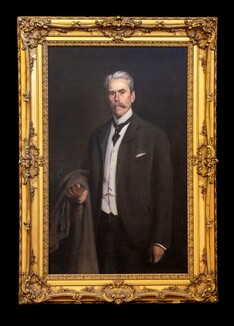|
No discussion about plastic can be had without knowledge of how we got here. It begins with ivory. Its historical source is rooted in the carnage of killing elephants (mostly), whales, walruses, narwhals, hippopotamuses, and warthogs for their tusks. Ivory was used for piano keys, hair combs, men’s dress collars, dentures, religious items, jewelry and incredibly, billiard balls. Billiards was a huge indoor recreational game in the late 19th century. Ivory billiard ball Ivory’s burgeoning demand gave way to the desire to find a suitable and less expensive substitute. Celluloid was the first commercial response to this need. Henry Stanton Chapman, the Glen Ridge Library’s original benefactor, made his fortune in celluloid manufacturing. He owned and operated the Arlington Company in Arlington, NJ, which is a neighborhood in Kearny. He sold it to DuPont circa 1914. He then went on to manage his investments and engage in local philanthropic endeavors in Glen Ridge. His $50,000 donation provided the funds to build our library, which opened to the public in May 1918. Celluloid’s popularity began to wane toward the middle of the 20th century, following the introduction of plastics based on entirely synthetic polymers created from petroleum. The word “plastic” come from the Greek word "plastikos," which means “capable of being shaped or molded.” 1907 - Bakelite is invented. 1939 - Nylon is launched. 1941 - PET (polyethylene terephthalate) is first produced. PET is now used to make plastic bottles. 1939 to 1945 - Plastics are in high demand during World War ll when plastics were molded and used for cockpits, and nylon for parachutes to hand grenades. 1950s - The first polyethylene bags appear. High-density polyethylene was developed, which made plastic bottles cheaper to manufacture and buy. Single-use plastics are ushered in. 1960s - Plastics are further toughened and refined, allowing them to compete with metals. Plastic inspired the iconic scene from “The Graduate” when Los Angeles businessman Mr. McGuire takes Dustin Hoffman’s character Benjamin Braddock aside and declares, “I just want to say one word to you just one word. Plastic.” Turns out, Mr. McGuire’s advice was prophetic. Here's the clip https://www.youtube.com/watch?v=PSxihhBzCj Plastic is durable, lightweight and malleable. This is both good news and bad news. Let’s start with good news: The advent of plastic revolutionized modern medicine. Laborious medical equipment sterilization yielded to the use of plastic IV bags, syringes, gloves, masks, bed pans, bandages and prosthetics. Plastic transformed blood-bank collection and storage, too. The bad news: Plastic is durable, lightweight, malleable and made from petroleum. The trouble started when plastic went from being a valuable material to something we were overusing and over-producing without a thought for what would happen when we threw it away. In post-WW ll America, plastic manufacturers shifted their attention and their advertising from military production to consumer items, many of which were single-use and disposable. Fast-forward to today: Single-use plastics are everywhere on land and in our oceans. It’s remarkable to think that a quest for an ivory replacement for billiard balls would lead us to where we are today. We live with plastics, and it lives within us. Plastics changed the essential texture of contemporary life; so, too, has it altered the basic chemistry of our bodies. It leeches into our bodies from plastics we use for food and liquid storage. Fish ingest it when they eat plastic objects, which they mistake for food then we eat the fish. And microplastics are endemic to our oceans. Microplastics are fragments of any type of plastic less than 5 mm in length, according to the U.S. National Oceanic and Atmospheric Administration and the European Chemicals Agency. Microplastics are found in upcycled clothing and other items made from plastics. It’s in our air when plastic is incinerated and releases gases into the atmosphere. Plastic has morphed from an engineering triumph into a global plague – a double-edged sword with consequences both positive and negative. We need to wield our swords, and sharpen our senses and strengths to combat and challenge our unwieldy use of non-essential single-use plastics while diligently working to discover, or invent alternative inert and non-toxic substances that replicate the positive properties of plastics which have revolutionized our world. Perhaps, a global competition could accelerate this mission, just as a $10,000 prize offered by the Albany Billiard Ball Co., manufacturer in the 1800s ignited the creation of celluloid by John Hyatt Jr. in 1868, followed by an improved patent with his brother, Isaiah S. Haytt in 1870 which evolved into the plethora of plastics were know today. Learn MoreJulie, Beer. Kids vs plastic: ditch the straw and find the pollution solution to bottles, bags, and other single-use plastics. Washington, D.C.: National Geographic, 2020. French, Jess. What a waste: trash, recycling, and protecting our planet. New York, NY:, DK Publishing, 2019. Plastic soup Foundation https://www.plasticsoupfoundation.org/en/
0 Comments
|
Curiosity Corner writer & contributor:Helen Beckert, Reference Librarian at the Glen Ridge Public Library Archives
June 2023
Categories |
|
Glen Ridge Public Library
240 Ridgewood Avenue Glen Ridge, NJ 07028 Phone: 973-748-5482 Email: [email protected] © 2024 Glen Ridge Public Library Site last updated July 15, 2024 |
LIBRARY HOURS Monday 9 am - 8 pm Tuesday 9 am - 8 pm Wednesday 9 am - 8 pm Thursday 9 am - 5 pm Friday 9 am - 5 pm Saturday 9 am - 5 pm Sunday CLOSED |







 RSS Feed
RSS Feed
